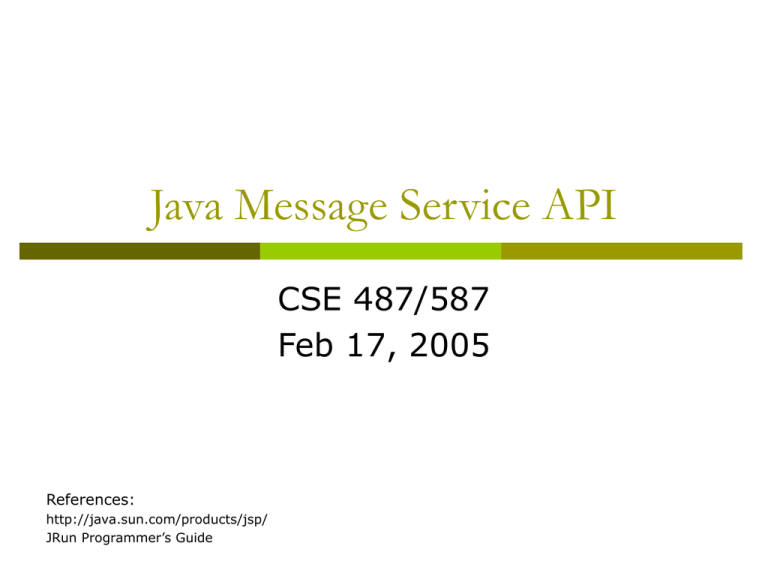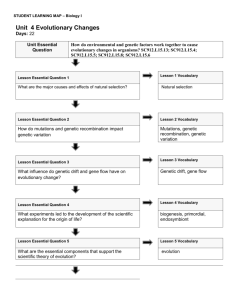Java Message Service API CSE 487/587 Feb 17, 2005 References:
advertisement

Java Message Service API
CSE 487/587
Feb 17, 2005
References:
http://java.sun.com/products/jsp/
JRun Programmer’s Guide
Additional Notes
Project 1 deadline extended to March 6
Will cover JMS concepts today
Practical example to be covered in the
recitations next week
Today’s lecture should let you finalize your
project design
Introduction
The Java Message Service API allows
applications to create, send, receive and
read messages using reliable,
asynchronous, loosely coupled
communication
It is part of the J2EE specification since
J2EE ver 1.3. Hence, every implementation
of J2EE (JRun, WebSphere) must support
JMS.
Introduction (contd.)
Loosely-coupled: Sender and receiver
need not be available at the same time. In
fact they can be oblivious of each other.
They only need to know the “destination”
and the format of the message
Different from RPC (tightly-coupled) and
e-mail (humans)
JMS API Architecture
JMS Provider is a messaging system that
implements the JMS interfaces and
provides admin and control features.
JRun has its own built-in JMS Provider. It
can also support external providers.
JMS Clients are the programs or
components written in Java that produce
and consume messages. Any J2EE
component can act as a JMS Client.
JMS API Architecture (contd.)
Messages are the objects that
communicate information between JMS
Clients
Administered Objects are preconfigured
JMS objects created by an administrator
for the use of clients.
Destinations
Connection Factories
Messaging Domains
Point-to-Point Messaging (PTP)
Each message is addressed to a
specific queue, and receiving clients
extract messages from these
queues.
Queues retain all messages sent to
them until the messages are
consumed or until the messages
expire.
Each message has only one
consumer.
A sender and a receiver of a
message have no timing
dependencies. The receiver can
fetch the message whether or not
it was running when the client sent
the message.
The receiver acknowledges the
successful processing of a
message.
Messaging Domains (contd.)
Publish-Subscribe (Pub-Sub)
Clients address messages to a
topic, which functions somewhat
like a bulletin board.
The system takes care of
distributing the messages from
publishers to subscribers.
Publishers and subscribers have
a timing dependency. A client
that subscribes to a topic can
consume only messages
published after the client has an
active subscription to the topic.
Exception: Durable
Subscriptions
Topics retain messages only as
long as it takes to distribute them
to current subscribers.
Each message can have zero or
multiple consumers.
Message Consumption
Receivers can consume messages in the following two ways
(JMS is inherently asynchronous. Here, we use the following
terms in a slightly different sense.):
Synchronous: A subscriber or a receiver explicitly fetches the
message from the destination by calling the receive method.
The receive method can block until a message arrives or can
time out if a message does not arrive within a specified time
limit.
Asynchronous: A client can register a message listener with
a consumer. A message listener is similar to an event listener.
Whenever a message arrives at the destination, the JMS
provider delivers the message by calling the listener's
onMessage method, which acts on the contents of the
message.
Message-driven beans use Asynchronous Message
Consumption
JMS API Programming Model
Objects involved in JMS Programming
JMS API Programming Model
Administered Objects: These objects may be
implemented differently in every JMS
implementation. Hence, they are set up
administratively rather than through code, using
admin tools provided by the JMS implementation.
Of course, these objects implement interfaces
that are specified by the JMS (J2EE) specification.
Two objects: ConnectionFactory & Destination
JMS API Programming Model
Administered Objects (contd.)
Connection Factory
A connection factory is the object a client uses to create a
connection to a provider.
Each connection factory is an instance of the
ConnectionFactory, QueueConnectionFactory, or
TopicConnectionFactory interface.
At the beginning of a JMS client program, you usually
perform a JNDI lookup of a connection factory, then cast and
assign it to a ConnectionFactory object.
For example,
Context ctx = new InitialContext();
ConnectionFactory cFactory = (ConnectionFactory)
ctx.lookup("jms/ConnectionFactory");
JMS API Programming Model
Administered Objects (contd.)
Destinations
A destination is the object a client uses to specify the
target of messages it produces and the source of messages
it consumes
Queues in PTP and Topics in Pub/Sub. A JMS application
can use multiple queues or topics (or both).
A destination must be looked up using the Context and
then casted to the Destination, Queue or Topic.
For example,
Destination MyDest = (Destination)
ctx.lookup("jms/MyTopic");
Queue myQueue = (Queue) ctx.lookup("jms/MyQueue");
JMS API Programming Model (contd.)
Connections
A connection encapsulates a virtual connection with a JMS
provider
You use a connection to create one or more sessions. When
you have a ConnectionFactory object, you can use it to create
a Connection:
Connection conn =
cFactory.createConnection();
Before an application completes, you must close any
connections that you have created. Failure to close a
connection can cause resources not to be released by the JMS
provider. Closing a connection also closes its sessions and their
message producers and message consumers
conn.close();
Before your application can consume messages, you must call
the connection's start method. If you want to stop message
delivery temporarily, you call the stop method
JMS API Programming Model (contd.)
Sessions
A session is a single-threaded context for producing and
consuming messages. You use sessions to create message
producers, message consumers, and messages
A session provides a transactional context with which to group
a set of sends and receives into an atomic unit of work
After you create a Connection object, you use it to create a
Session:
Session session = conn.createSession(false,
Session.AUTO_ACKNOWLEDGE);
The first argument means that the session is not transacted;
the second means that the session automatically
acknowledges messages when they have been received
successfully.
JMS API Programming Model (contd.)
Message Producers
A message producer is an object that is created by a Session
and used for sending messages to a Destination
You use a Session to create a MessageProducer for a
Destination:
MessageProducer producer = session.createProducer(myQueue);
MessageProducer producer = session.createProducer(myTopic);
After you have created a message producer, you can use it to
send messages by using the send method:
producer.send(message);
You must first create the messages
JMS API Programming Model (contd.)
Message Consumers
A message consumer is an object that is created by a session
and used for receiving messages sent to a destination
A message consumer allows a JMS client to register interest in
a destination with a JMS provider
The JMS provider manages the delivery of messages from a
destination to the registered consumers of the destination
For example, you use a Session to create a MessageConsumer
for either a queue or a topic:
MessageConsumer consumer = session.createConsumer(myQueue);
MessageConsumer consumer = session.createConsumer(myTopic);
JMS API Programming Model
Message Consumers (contd.)
After you have created a message consumer, it becomes
active, and you can use it to receive messages
You can use the close method for a MessageConsumer to make
the message consumer inactive
Message delivery does not begin until you start the connection
you created by calling its start method
You use the receive method to consume a message
synchronously
conn.start();
Message m = consumer.receive();
conn.start();
Message m = consumer.receive(1000); // time out after a sec
JMS API Programming Model (contd.)
Message Listeners
(Asyncronous Message Consumption)
A message listener is an object that acts as an asynchronous
event handler for messages
This object implements the MessageListener interface, which
contains one method, onMessage
In the onMessage method, you define the actions to be taken
when a message arrives
The onMessage method takes one argument of type Message,
which your implementation of the method can cast to any of
the other message types
You register the message listener with a specific
MessageConsumer by using the setMessageListener method
JMS API Programming Model
Message Listeners (contd.)
For example,
Listener myListener = new Listener();
consumer.setMessageListener(myListener);
After you register the message listener, you call the start
method on the Connection to begin message delivery
The onMessage method is called by the JMS Provider when a
message is delivered
Your onMessage method should handle all exceptions. It must
not throw checked exceptions
At any time, only one of the session's message listeners is
running
JMS API Programming Model (contd.)
Message Selectors
If your messaging application needs to filter the messages it
receives, you can use a JMS API message selector, which
allows a message consumer to specify the messages it is
interested in
Message selectors assign the work of filtering messages to the
JMS provider rather than to the application
A message selector is a String that contains an expression
The createConsumer method allows you to specify a message
selector as an argument when you create a message consumer
The message consumer then receives only messages whose
headers and properties match the selector. A message selector
cannot select messages on the basis of the content of the
message body.
JMS API Programming Model (contd.)
Messages
The ultimate purpose of a JMS application is to produce and to
consume messages that can then be used by other software
applications
JMS messages have a basic format that is simple but highly
flexible
A JMS message has three parts: a header, properties, and a
body
JMS API Programming Model
Messages (contd.)
Message Headers
A JMS message header
contains a number of
predefined fields that
contain values that both
clients and providers use
to identify and to route
messages
Each header field has
associated setter and
getter methods
Some header fields are
intended to be set by a
client, but many are set
automatically by the send
or the publish method,
which overrides any
client-set values.
Header Field
Set By
JMSDestination
send or publish method
JMSDeliveryMode
send or publish method
JMSExpiration
send or publish method
JMSPriority
send or publish method
JMSMessageID
send or publish method
JMSTimestamp
send or publish method
JMSCorrelationID
Client
JMSReplyTo
Client
JMSType
Client
JMSRedelivered
JMS provider
JMS API Programming Model
Messages (contd.)
Message Properties
You can create and set properties for messages if you need
values in addition to those provided by the header fields. You can
use properties to provide compatibility with other messaging
systems, or you can use them to create message selectors
The JMS API provides some predefined property names that a
provider can support. The use either of these predefined
properties or of user-defined properties is optional
Message Bodies
The JMS API defines five message body formats, also called
message types
The JMS API provides methods for creating messages of each
type and for filling in their contents.
JMS API Programming Model
Messages (contd.)
For example,
TextMessage message = session.createTextMessage();
message.setText(msg_text);
// msg_text is a String
producer.send(message);
At the consuming end, a message arrives as a generic Message
object and must be cast to the appropriate message type:
Message m = consumer.receive();
if (m instanceof TextMessage) {
TextMessage message = (TextMessage) m;
System.out.println("Reading message: " +
message.getText());
} else {
// Handle error
}
JMS API Programming Model
Messages (contd.)
Message Type
Body Contains
TextMessage
A java.lang.String object (for example, the contents of an Extensible
Markup Language file).
MapMessage
A set of name-value pairs, with names as String objects and values as
primitive types in the Java programming language. The entries can be
accessed sequentially by enumerator or randomly by name. The order of
the entries is undefined.
BytesMessage
A stream of uninterpreted bytes. This message type is for literally encoding a body to
match an existing message format.
StreamMessage
A stream of primitive values in the Java programming language, filled and read
sequentially.
ObjectMessage A Serializable object
Message
Nothing. Composed of header fields and properties only. This message type is
useful when a message body is not required.

